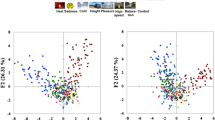Abstract
Experiment 1 explored the impact of physically touching a virtual object on how realistic the virtual environment (VE) seemed to the user. Subjects in a ‘no touch’ group picked up a 3D virtual image of a kitchen plate in a VE, using a traditional 3D wand. ‘See and touch’ subjects physically picked up a virtual plate possessing solidity and weight, using a technique called ‘tactile augmentation’. Afterwards, subjects made predictions about the properties of other virtual objects they saw but did not interact with in the VE. ‘See and touch’ subjects predicted these objects would be more solid, heavier, and more likely to obey gravity than the ‘no touch’ group. In Experiment 2 (a pilot study), subjects ‘physically bit’ a chocolate bar in one condition, and ‘imagined biting’ a chocolate bar in another condition. Subjects rated the event more fun and realistic when allowed to physically bite the chocolate bar. Results of the two experiments converge with a growing literature showing the value of adding physical qualities to virtual objects. This study is the first to empirically demonstrate the effectiveness of tactile augmentation as a simple, safe, inexpensive technique with large freedom of motion for adding physical texture, force feedback cues, smell and taste to virtual objects. Examples of practical applications are discussed.
Similar content being viewed by others
References
Burdea GC. Force and touch feedback for virtual reality. New York: Wiley, 1996
Barfield W, Dana E. Comments on the use of olfactory displays for virtual environments. Presence: Teleoperators and Virtual Environments 1996; 5:109–121
Hoffman HG, Groen J, Rousseau S, Hollander A, Winn W, Wells M, Furness III T. Tactile augmentation: enhancing presence in inclusive VR with tactile feedback from real objects. Presented at the meeting of the American Psychological Sciences, San Francisco, 1996
Hoffman HG. Physically touching virtual objects using tactile augmentation enhances the realism of virtual environments. In: Proceedings of the IEEE Virtual Reality Annual International Symposium '98, Atlanta GA, pp 59–63. Los Alamitos, CA: IEEE Computer Society, 1998
Welch RB, Warren DH. Immediate perceptual response to intersensory discrepancy. Psychological Bulletin 1980; 88:638–667
Burdea G, Richard P, Coiffet P. Multimodal virtual reality: input-output devices, system integration, and human factors. International Journal of Human-Computer Interaction 1996; 8:5–24
Gift AG. Visual analogue scales: measurement of subjective phenomena. Nursing Research 1989; 38:286–288
Huskisson DC. Measurement of pain. Lancet 1974; II:1127–1131
Keppel G. Design and analysis: a researcher's handbook, 2nd edn. Englewood Cliffs, NJ: Prentice-Hall, 1982
Cater JP. The noses have it! Presence: Teleoperators and Virtual Environments 1992; 1:493–494
Helig ML, El cine del futuro: The cinema of the future. Presence: Teleoperators and Virtual Environments 1992; 1:279–294
Richardson JT, Zucco GM. Cognition and olfaction: a review. Psychological Bulletin 1989; 105:352–360
Hoffman HG, Prothero J, Wells M, Groen J. Virtual chess: the role of meaning in the sensation of presence. International Journal of Humar-Computer Interaction 1998; 10:251–263
Perry S, Heidrich G, Ramos E. Assessment of pain by burn patients. Journal of Burn Care and Rehabilitation 1981; 2:322–327
Patterson D, Ptacek JT, Carrougher G, Sharar S. Lorazepam as an adjunct to opioid analgesics in the treatment of burn pain. Pain 1997; 72:367–374
Patterson DR, Everett JJ, Burns GL, Marvin JA. (1992). Hypnosis for the treatment of burn pain. Journal of Consulting and Clinical Psychology 1992; 60:713–717
Chapman CR, Nakamura Y, Hypnotic analgesia: a constructionist framework. International Journal of Clinical and Experimental Hypnosis 1998; 1:6–27
Laurel B. Virtual reality. Scientific American 1995; September: 90
Hoffman HG, Doctor JN, Patterson DR, Canougher GJ, Furness III TA. Use of virtual reality for adjunctive treatment of adolescent burn pain during wound care; a case report. Pain (in press)
Rothbaum BO, Hodges LF, Kooper R, Opdyke D, Williford J, North MM. Effectiveness of virtual reality graded exposure in the treatment of acrophobia. American Journal of Psychiatry 1995; 52:626–628
Carlin AS, Hoffman HG, Weghorst S. Virtual reality and tactile augmentation in the treatment of spider phobia: a case study. Behaviour Research and Therapy 1997; 35:153–158
Hoffman HG, Hullfish KC, Houston S. Virtual-reality monitoring. In: Proceedings of the Virtual Reality Annual International Symposium '95, pp 48–54. Los Alamitos, CA: IEEE Computer Society Press, 1995
Johnson MK, Raye CL. Reality monitoring. Psychological Review 1981; 88:67–85
Hoffman HG, Beecher JE. Virtual-reality monitoring: separating real from virtual memories. Paper presented at Medicine Meets. Virtual Reality 7, San Francisco, CA, 1999
Dywan J, Jacoby L. Effects of aging on source monitoring: differences in susceptibility to false fame. Psychology and Aging 1990; 5:379–387
Risden K, Czerwinski M, Worley S, Hamilton L, Kubiniec J, Hoffman HG, Mickel N, Loftus EF. Interactive advertising: patterns of use and effectiveness. In: Proceedings of CHI '98, Human Factors in Computing Systems. Los Angeles, CA, 21–23 April, pp 219–224. New York: ACM Press, 1998
Brooks FP Jr, Ming O-Y, Batter JJ, Kilpatrick PJ. Project GROPE: haptic displays for scientific visualization. Computer Graphics 1990; 24:177–185
Robinett W, Rolland JP. A computational model for the stereographic optics of a head-mounted display. Presence: Teleoperators and Virtual Environments 1992; 1:45–62
Roscoe SN. Judgments of size and distance with imaging displays. Human Factors 1984; 21:617–629
Rolland JP, Gibson W, Ariety D. Towards quantifying cepth and size perception in virtual environments. Presence: Teleoperators and Virtual Environments 1995; 4:24–49
Author information
Authors and Affiliations
Corresponding author
Additional information
Based in part on ‘Physically touching virtual objects using tactile augmentation enhances the realism of virtual environments' by Hunter Hoffman which appeared in the Proceedings of the IEEE Virtual Reality Annual International Symposium '98, Atlanta GA, pp 59–63. ¢ 1998 IEEE.
Rights and permissions
About this article
Cite this article
Hoffman, H.G., Hollander, A., Schroder, K. et al. Physically touching and tasting virtual objects enhances the realism of virtual experiences. Virtual Reality 3, 226–234 (1998). https://doi.org/10.1007/BF01408703
Issue Date:
DOI: https://doi.org/10.1007/BF01408703




